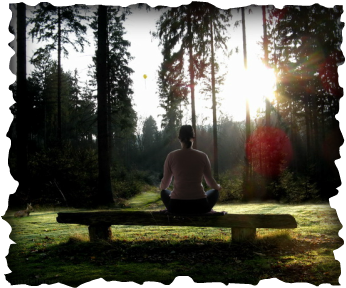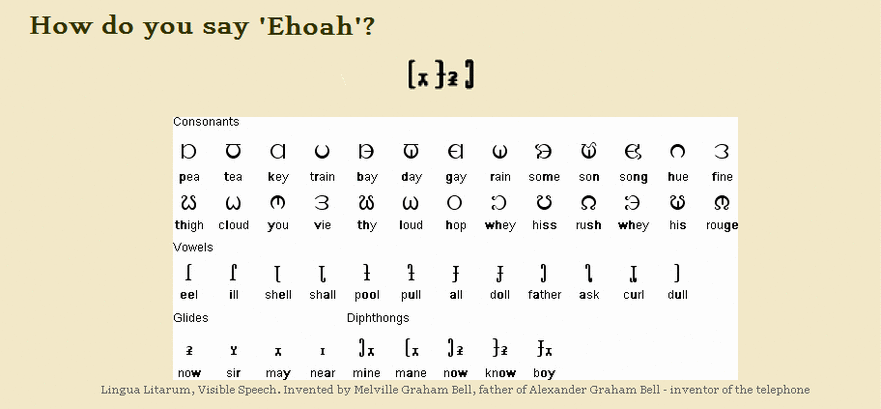Meditation
|
Meditation can be used to overcome mental, social or physical obstacles.
Below are a few options of what you can do in your Meditations
Below are a few options of what you can do in your Meditations
Ehoah Breathing Exercise & Mantra
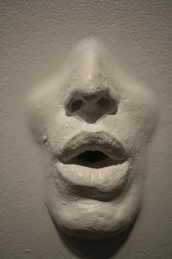
This is a very simple exercise that can go on for however long you desire. 15 minutes is recommended to get the minimum full effect, yet can be used in shorter time frames to treat stress.
In a comfortable, relaxed position, take a deep breath through your nose and breathe out of your mouth. Take another deep breath through your nose and say “Eh” (“Eh”= 'A' as in able), “O” (as in oak), and “Ah” (“Ah”= 'A' as in dawn) for about 8 seconds each in one exhale. Take a deep breath through your nose and begin again. With practice, you can extend the length of time for each syllable.
With practice, you can extend the length of time for each syllable.
Awareness Meditation
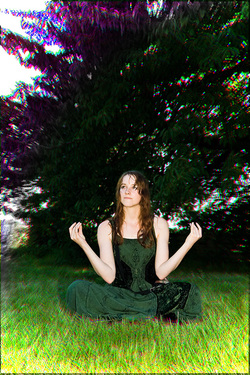
Taking in your surroundings with all available senses and being in the moment
In a comfortable upright position, relax and leave your eyes open. Start with your core and work your way out.
Heartbeat: Focus on your heartbeat. Feel it. Then let your mind empty while remaining conscious of your heartbeat.
Breath: Feel your breath coming in and out. Then let your mind empty while remaining conscious of your breath.
Touch: Sense all that touches your skin: the wind, the sun, the grass. Feel the stillness. Then let your mind empty while remaining conscious of your sense of touch.
Ground: Whatever part of you is touching the ground (your feet if you're standing, your bottom if sitting, etc.), feel the sturdy ground beneath you. Embrace it. Then let your mind empty while remaining conscious of the ground.
Sound: Listen to whatever sound you hear: leaves and grasses in wind, birdsong, etc. Don't focus on any particular sound. Let the sounds come to you. Then let your mind empty while remaining conscious of sound.
Sight: Widen your vision to include everything up to your peripheral vision. Take in what you see. Maintaining a wide view, notice any stillness or movement, without turning your vision directly on it. Then let your mind empty while remaining conscious of sight.
Try to maintain this state for as long as possible, over time and with much practice you will be able to reach Awareness faster and easier.
This form of meditation is also commonly referred to as 'Grounding'.
In a comfortable upright position, relax and leave your eyes open. Start with your core and work your way out.
Heartbeat: Focus on your heartbeat. Feel it. Then let your mind empty while remaining conscious of your heartbeat.
Breath: Feel your breath coming in and out. Then let your mind empty while remaining conscious of your breath.
Touch: Sense all that touches your skin: the wind, the sun, the grass. Feel the stillness. Then let your mind empty while remaining conscious of your sense of touch.
Ground: Whatever part of you is touching the ground (your feet if you're standing, your bottom if sitting, etc.), feel the sturdy ground beneath you. Embrace it. Then let your mind empty while remaining conscious of the ground.
Sound: Listen to whatever sound you hear: leaves and grasses in wind, birdsong, etc. Don't focus on any particular sound. Let the sounds come to you. Then let your mind empty while remaining conscious of sound.
Sight: Widen your vision to include everything up to your peripheral vision. Take in what you see. Maintaining a wide view, notice any stillness or movement, without turning your vision directly on it. Then let your mind empty while remaining conscious of sight.
Try to maintain this state for as long as possible, over time and with much practice you will be able to reach Awareness faster and easier.
This form of meditation is also commonly referred to as 'Grounding'.
Awareness Walking
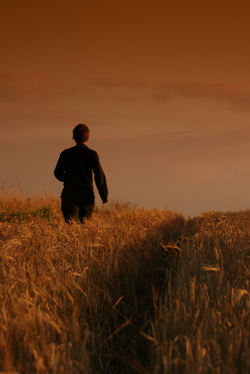
While in the Awareness state, take each step slowly and intentionally,
feeling the ground beneath your feet.
Let your mind empty.
Move slowly around the space while maintaining your Awareness
Let your mind be receptive to the sounds and
movements around you without focusing on them.
Keep your senses aware, and your mind empty of thought.
feeling the ground beneath your feet.
- Ankles loose
- Knees Springy
Let your mind empty.
Move slowly around the space while maintaining your Awareness
- Take in how quietly you can walk and how small noises become loud
Let your mind be receptive to the sounds and
movements around you without focusing on them.
Keep your senses aware, and your mind empty of thought.
Methods to Enhance Effects of Meditation
The result of meditation may be enhanced if done
right before sleep. This in itself can become even more effective if
done in the wilderness under an open night sky, and possibly solo if the
practitioner is comfortable with this. Having an open fire will likely
distract the practitioner so an associate may be required if this is
deemed necessary. Sometimes meditation alongside
moving water enhances the effectiveness and other times still water is
better (a public fountain/pond or a small home fountain/fish pond can be used too) followed by sleep. The current phase of the moon may be something to consider, Lunanox (new moon) is often considered the best time for such deep meditations. Meditation done outside is only recommended during warm
weather and clear skies otherwise utilize a tent or lodge.
Once again this can be triply effective if a sweat-house/lodge/sauna or a home sweat is done (will make link available or provide more information on home sweats in future) then submergence of oneself in the water previously mentioned (or a bath) prior to meditation and sleep. Completing this whole process while skyclad may be more effective for certain individuals (remember sunblock if you are considering doing this outside during the day and incense, smudging, or lotion that is offensive to biting insects).
A practitioner should only progress to the more in-depth techniques if they are comfortable with it, and may pick and choose which techniques they prefer.
If you reside in an urban environment and a park or waterworks are not nearby, you can still meditate on balconies, benches, staircases, rooftops (if available), etc. While in your home, you can have a small fountain and plants to create a more balanced environment. (information on creating home sweats will become available at a later time)
Once again this can be triply effective if a sweat-house/lodge/sauna or a home sweat is done (will make link available or provide more information on home sweats in future) then submergence of oneself in the water previously mentioned (or a bath) prior to meditation and sleep. Completing this whole process while skyclad may be more effective for certain individuals (remember sunblock if you are considering doing this outside during the day and incense, smudging, or lotion that is offensive to biting insects).
A practitioner should only progress to the more in-depth techniques if they are comfortable with it, and may pick and choose which techniques they prefer.
If you reside in an urban environment and a park or waterworks are not nearby, you can still meditate on balconies, benches, staircases, rooftops (if available), etc. While in your home, you can have a small fountain and plants to create a more balanced environment. (information on creating home sweats will become available at a later time)
|
Summary of Enhancement Options:
Meditate Before Sleeping In Wilderness (unaltered Landscape) Open night sky Solo By Moving Water By Still Water Moon Phase Sweat-House/Lodge/Sauna, then Submergence in Waters Skyclad |
|
Copyright Rua Lupa 2011
External Links
|
Meditation 101: Techniques, Benefits & Beginner’s How-to - life.gaiam.com
How to Be More Mindful Just By Breathing and Walking - life.gaiam.com Meditation Techniques, Types and Practice – A Comprehensive Guide - anmolmehta.com The Tree of Contemplative Practices (An illustration of various forms of meditation) - contemplativemind.org If you are meditating in your home, the virtual Gaiam Life Meditation Room may assist in creating that wilderness atmosphere. "Experienced meditators can switch off brain areas associated with daydreaming and psychiatric disorders like autism and schizophrenia, says brain imaging study."- EarthSky "Meditation produced a greater reduction in pain than even morphine or other pain-relieving drugs.." - physorg.com "experienced meditators had decreased activity in areas of the brain called the default mode network, which has been implicated in lapses of attention and disorders such as anxiety, attention deficit and hyperactivity disorder, and even the buildup of beta amyloid plaques in Alzheimer's disease. The decrease in activity in this network, consisting of the medial prefrontal and posterior cingulate cortex, was seen in experienced meditators regardless of the type of meditation they were doing." - physorg.com |
"Several clinical studies have documented specific ways that meditating may help people stay healthier, sharpen mental focus and gain more power over their emotions. Some studies even show that the brain of someone who meditates may be physically different from the next guy’s." - life.gaiam.com
"Study participants who completed an eight-week meditation training course had reduced activity in the right amygdala in response to emotional images, even when not meditating... supporting the hypothesis that meditation can improve emotional stability and response to stress." - physorg.com |

